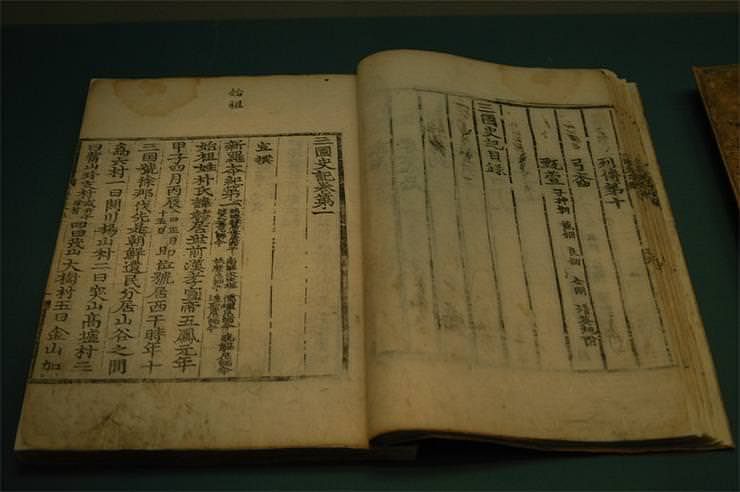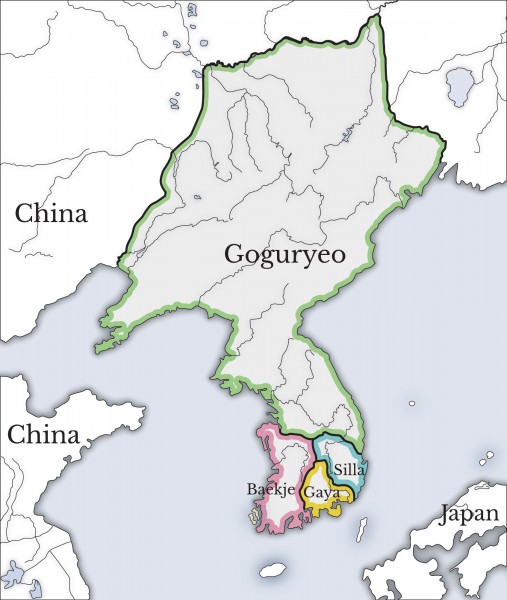Samguk Sagi › Stupa » Ancient origins
Articles and Definitions › Contents
- Samguk Sagi › Ancient History
- Stupa › Ancient History
Ancient civilizations › Historical and archaeological sites
Samguk Sagi › Ancient History
Definition and Origins

The Samguk sagi ('History of the Three Kingdoms' or 'Historical Records of the Three States') is a 12th-century CE text written by Kim Pusik which is considered the first history of Korea. The text covers the history of Silla, Baekje ( Paekche ), and Goguryeo ( Koguryo ), the Three Kingdoms which dominated the Korean peninsula between the 1st century BCE and 7th century CE. Although the work is a history book, the primary motivation for its compilation was the long-held East Asian view that history can help guide the present and offer valuable practical lessons on good government and moral conduct.
AUTHORSHIP
The Samguk sagi is thought to have been commissioned by King Injong of Goryeo (1122-1146 CE), the kingdom which ruled Korea from 918 to 1392 CE. The man given the task of compiling Korea's first official history was Kim Pusik (1075-1151 CE), a Confucian scholar and court official of Silla descent – all points which are evident in Kim's selection of material and commentaries. Kim had already gained fame when he successfully led a Goryeo army to quash the Myochong rebellion of 1135-36 CE. Kim and his ten assistants set about gathering older sources and although specific citations are rare, the bibliography of the Samguk sagi lists 69 Korean and 123 Chinese works consulted. The most important of these was the now lost Ku samguk sa ('Old Three Kingdoms History'). Kim modelled his presentation on what became the classic history textbook of the time, the Shiji by Sima Qian (c. 145-86 BCE), China 's first historian. Kim's final version was completed and presented to the Goryeo court in 1145 CE.
THE SAMGUK SAGI HAS HAD A PROFOUND EFFECT ON THE VERY IDEA OF WHAT WAS ANCIENT KOREA & SOWED THE FIRST SEEDS OF KOREAN NATIONALISM.
SUBJECT MATTER
Imitating the jizhuan (Korean: kijon ) approach of Sima Qian, the Samguk sagi begins with a chronological year-by-year presentation of each of the three kingdoms – Silla, Goguryeo, and Baekje – from their founding to their collapse and the beginning of the Goryeo state. Silla has twelve chapters devoted to its history, Goguryeo ten, and Baekje six. The state of Barhae ( Parhae ), which governed a part of northern Korea and Manchuria from the 7th to 10th century CE, is not covered.These history sections are known as benji in Chinese and pongi in Korean. Next, there are three chapters of chronological reference tables ( yonpyo ) and then a number of essays ( zhi in Chinese, chi in Korean) spread over nine chapters and dealing with different aspects of Korean culture such as religious ceremonies, local geography, law, economics, astronomy, traditional clothing, and music. The book concludes with ten chapters containing 52 main and 34 secondary biographies of people instrumental in the history of Korea ( liezhuan in Chinese or yolchon in Korean). The figures covered include artists, scholars, political rebels, virtuous women, generals, and statesmen. The biography of the general Kim Yushin is typical and weaves a historical narrative of his great deeds with myths and hearsay of his birth and miraculous explanations of his victories on the battlefield.
Whilst some attempt was made to present the facts only, the Samguk sagi does reflect the Confucian view of the world which was prevalent at that time in the Goryeo kingdom, both in presentation and in the choice of texts and topics included. It also contains many points of commentary by Kim, as was traditional, to highlight what he perceived as praiseworthy actions and those he considered as failings.

Three Kingdoms of Korea
Besides history, the Samguk sagi contains many myths and legends. One of the most famous is the story of Prince Hodong.The handsome prince of Goguryeo was one day offered the daughter of the Chinese governor of Nangnang, Choe Ri, but he declined unless she proved herself worthy. The governor had a mysterious drum and horn instrument which sounded whenever an enemy approached and Prince Hodong insisted the girl first destroy this, which she did. The wily prince then attacked Nangnang unannounced. The capital fell and the governor killed his daughter in revenge before surrendering himself to the prince. Hodong did later get his comeuppance, though, when he was falsely accused by his jealous step-mother of making improper advances. Rather than displease his father with an embarrassing episode, Hodong nobly committed suicide.The story and many other such tales were designed to illustrate proper and improper behaviour and chivalry.
LEGACY
The Samguk sagi had a sequel of sorts, the Samguk yusa ('Memorabilia of the Three Kingdoms') which was completed in 1285 CE by the Buddhist scholar-monk Iryon. The text covers the history and legends of Korea's founding right up to the 10th century CE and offers more on mythology and Buddhist culture than its predecessor.
In addition, as the Samguk sagi draws on hundreds of earlier sources it has become an invaluable reference work since many of these ancient texts have since been lost, including all 69 Korean texts referred to in the bibliography. Further, the book is itself a useful source for linguists studying the history of transliterated Chinese words, especially place names.
Perhaps its greatest contribution, though, is the effect the Samguk sagi has had on the very idea of what was ancient Korea and sowing the first seeds of Korean nationalism. By emphasising the role of the southern kingdom of Silla, representing Goryeo as its natural cultural successor, minimising the role of the northern Goguryeo kingdom, and ignoring the (also northern) contemporary state of Balhae, the picture given is of a Korean state politically and culturally unique and fully independent from its powerful northern neighbour China.
This article was made possible with generous support from the British Korean Society.
Stupa › Ancient History
Definition and Origins

The stupa, an architectural structure usually housing the cremated remains or possessions of important saintly figures, is considered to be the structural emblem and the most important type of monument of Buddhism. Most stupas have a very distinctive semi-spherical shape, often surrounded by a fence. As Buddhism was introduced in different regions, the basic architectural features of stupas were transformed into a variety of shapes reflecting the artistic expressions of those cultures.
ORIGIN OF THE STUPA IN THE BUDDHIST TRADITION
The Mahaparinirvana Sutra (an ancient Buddhist text describing the last days of the Buddha ) claims that after the Buddha passed away, his followers divided his cremated remains into eight portions. Each of the eight kingdoms in which the Buddha had lived received one portion of the relics, and a stupa was erected in each kingdom in order to house the remains. Buddhist sources claim that during the 3rd century BCE, the Mauryan Emperor Ashoka the Great ordered these eight stupas to be opened, further distributed the relics of the Buddha into 84,000 portions, and had stupas built over them all over the expanding Buddhist world.
STUPAS WERE CONSIDERED THE LIVING PRESENCE OF THE BUDDHA, HIS PROTECTIVE POWERS, AND HIS LIVING ENERGY.
The relics of the Buddha were not merely considered a commemorative symbol by the Buddhist community; they were believed to be the living presence of the Buddha, a depository of his protective powers and living energy. Early in the Buddhist tradition, clergy and laity alike practiced the veneration of stupas and the relics in them in order to gain spiritual merit. The importance of the stupas gradually increased as a result of both the emphasis of the Buddhist relic-cult and their multiplication during the time of Ashoka. Stupas became a symbol not only of Buddhism itself but also an architectural testimony to its expansion and strength.
It should be noted that the veneration of stupas is not unique to Buddhism. This practice had its origin in Indian traditions pre-dating the emergence of Buddhism. From pre-historical times, burial mounds containing the remains of the dead were a common funerary practice in some Indian societies: in these mounds, the living paid homage to their dead, just like Buddhists would do for their saints centuries later.
STUPAS & EARLY BUDDHISM
The earliest archaeological evidence for the presence of stupas in North India dates to the late 4th century BCE. These are all pilgrimage stupas, which means that they were built outside the domains of monastic complexes, at pilgrimage sites. Although we have no material evidence of earlier stupas, Buddhist scriptures claim that stupas were built at least a century earlier. It is possible that before this time, stupas were built with non-durable materials such as wood, or even as burial mounds, in which case archaeological detection would be nearly impossible.
The earliest evidence of monastic stupas dates back to the 2nd century BCE. These are stupas that were built within Buddhist monastic complexes. It is possible that these stupas replaced older stupas made of wood: some of their architectural components were shaped imitating wooden parts. Unfortunately none of these left any visible trace.

The 'Great Stupa' at Sanchi
ARCHITECTURAL DEVELOPMENT OF THE STUPA
During early Buddhist times, stupas were composed of a semi-spherical dome with a parasol placed on top. The dome covered a square base with a small receptacle in the centre containing relics, while a space for circumambulation was defined around the dome. This basic format underwent changes as stupas were introduced in other cultures.
In Sri Lanka, the stupa is known as dagoba. Different shapes of domes developed in Sri Lanka, and a very unique architectural expression also developed, in which the dagoba itself was enclosed by a large dome known as vatadage, supported by columns located around the dagoba. Among the many vatadages built in Sri Lanka, there is one of particular importance named Thuparama, which supposedly houses the collarbone relic of the Buddha.
In Myanmar, the stupa, known as the zedi, also went through a number of changes. The parasol on top of the dome was elongated and resembled a cone, and the number of disks increased and their size decreased, the higher they are on the dome. The square base was also modified following a complex geometry, including different levels with terraces, and resembled the shape of a pyramid.
Pagoda is the name for stupas found in China, where they are shaped like a tower. Here, the dome was eliminated, and the emphasis is on verticality. This architectural form travelled into Korea, where it is known as Tap, and also into Japan, where it known as To.

The Great Stupa at Sanchi
THE IMPORTANCE OF STUPAS IN BUDDHISM
As the importance of the stupa grew, so it did its functions and meanings. In addition to being considered the living presence of the Buddha, his protective powers, and living energy, they were also a site of rituals and ceremonies. Their presence eventually attracted other constructions including monasteries.
The pilgrimage activity around the stupa had an important impact on the social history of Buddhism. Merchants, artisans, and monks alike enjoyed the benefits of the income generated by the activity resulting from the emblematic stupas. The religious function of the stupa was still central, but market activity and social interactions revolving around it were equally important for the communities where stupas were present.
LICENSE:
Article based on information obtained from these sources:with permission from the Website Ancient History Encyclopedia
Content is available under License Creative Commons: Attribution-NonCommercial-ShareAlike 3.0 Unported. CC-BY-NC-SA License